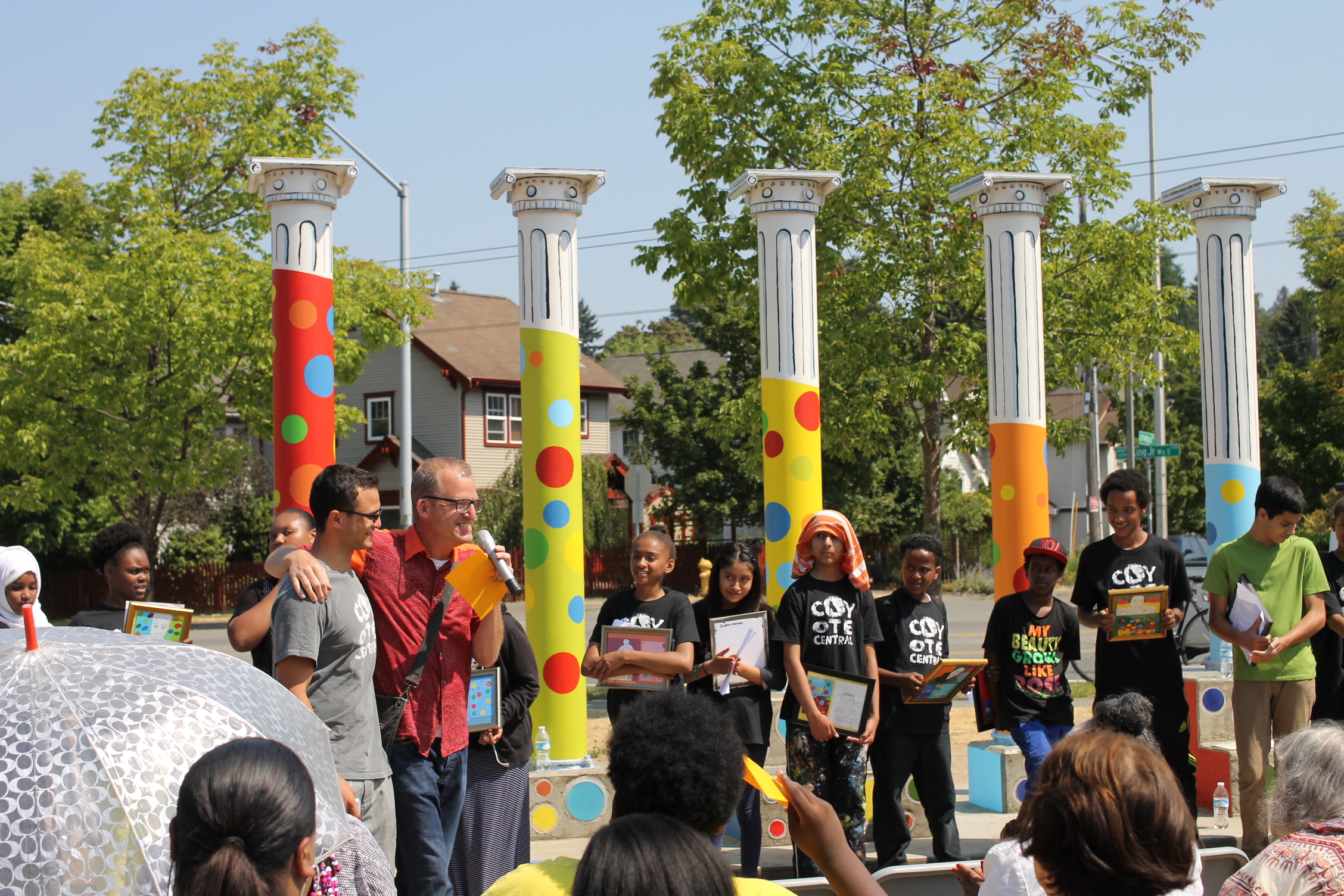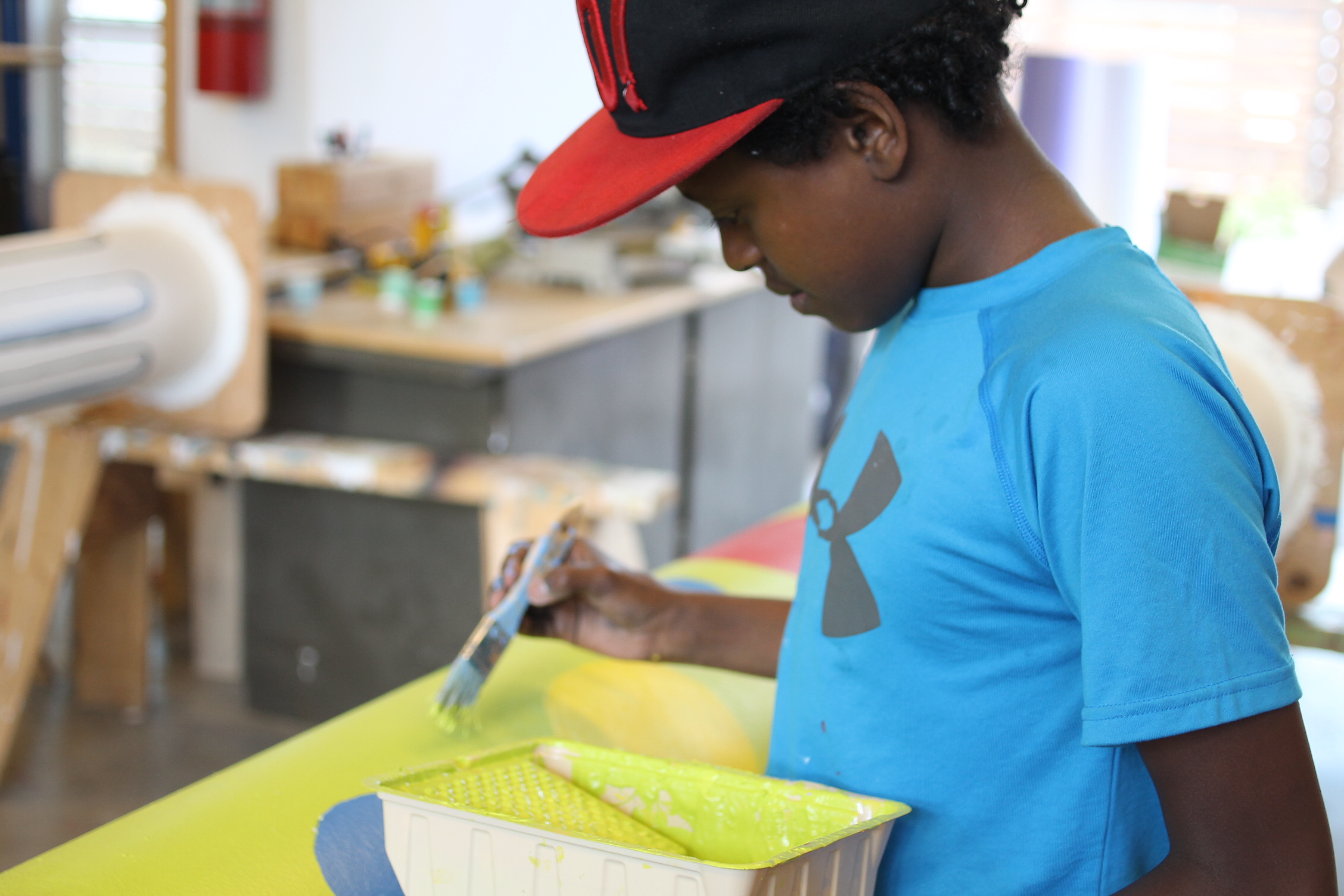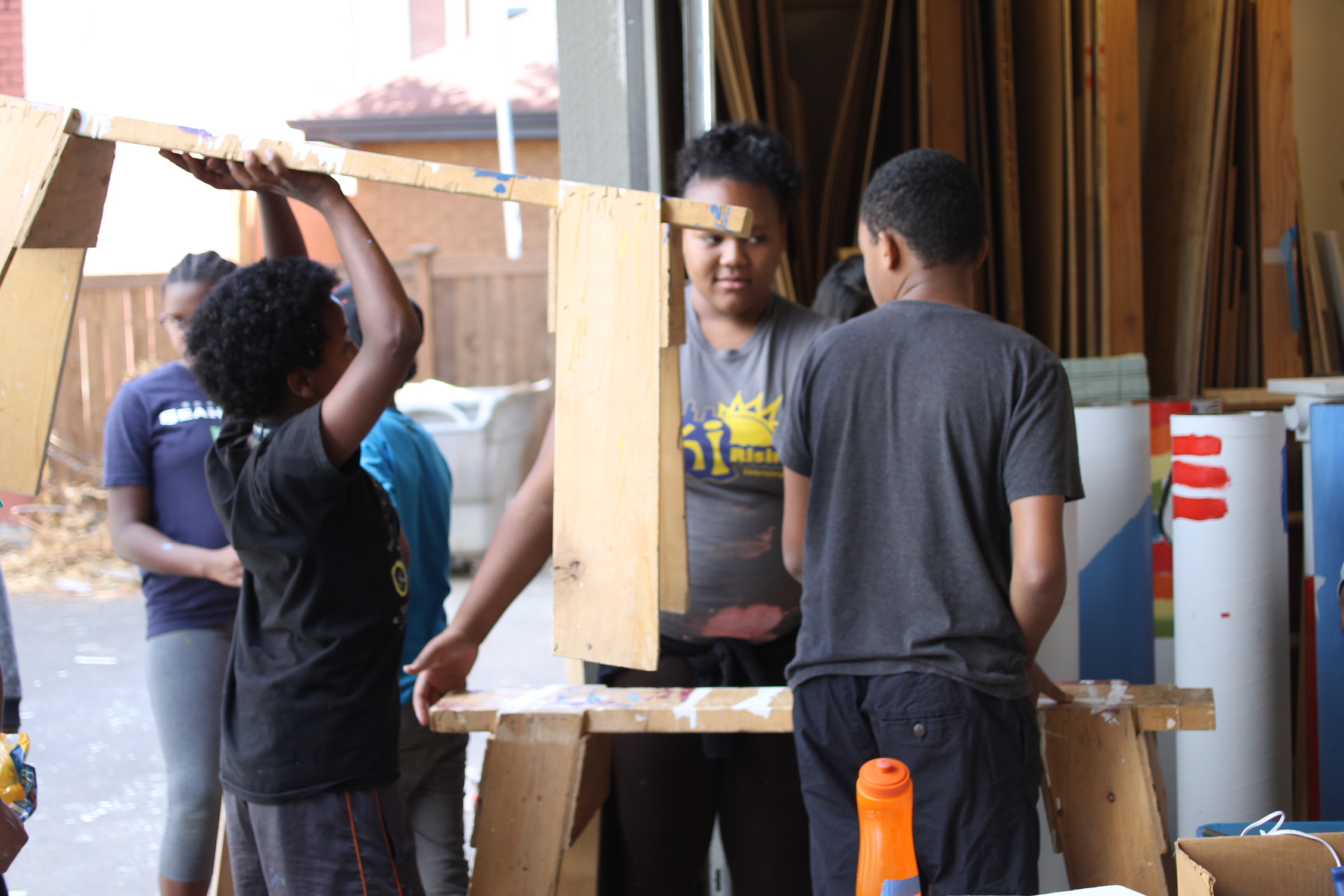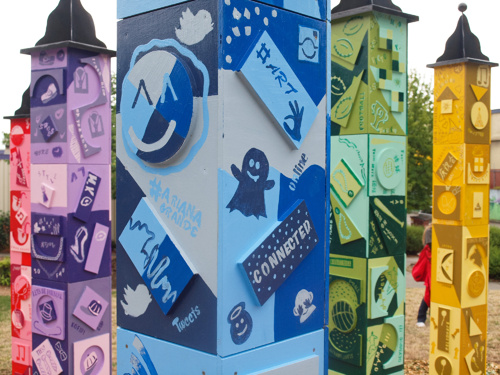
The kids at Coyote Central's building at 23rd and Cherry in Seattle mill around in a studio filled with paint buckets, welding equipment and — most strikingly — tall metal and wooden pillars. The kids are 12–14 years in age, decked out in jeans and T-shirts; some are nearly full-grown. They talk to each other, quick and lively as dolphins. But when I, a journalist, approach, they become shy.
Several pillars — assembled by those in the group who wanted to learn welding, then painted by those who wanted to learn painting — rest in a corner, the paint drying now. One pillar is painted in generous circles, an echo of a famous Japanese artist the kids studied. Another is geometrical in presentation. Another is adorned with an enormous rose painted in the warm colors the kids learned in color theory.
Welcome to Hit the Streets, an annual summer program run by arts nonprofit Coyote Central. The concept is simple: 24 kids from south and central Seattle get paid to work with and learn from professional artists, designing and creating a work of public art for their community. Each year a different community organization partners on the project.

This year's program ran from July 27–Aug.13, under the theme "Pillars of Diversity," and with the community partner Friends of Hit the Streets on MLK. On Aug. 13, the final work — a selection of five pillars created and painted by the kids — was installed in front of Thurgood Marshall Elementary School. After the work was installed and the ceremony honoring their work complete, they each received a stipend of $240 — payment for for three weeks of work on the art project (they worked four hours a days, four days a week).
The experience is momentous for these kids — to receive money in exchange for working with artists and learning hands-on skills. But even more momentous, perhaps, is the experience of being entrusted to create a permanent piece of public art.
"I have never gotten to do something like that," says Taevon, a participant in this year's program. "I thought the teacher was going to teach us but we wouldn’t get to do nothing, but then I started getting good at it and I was the one who welded the final piece. That was super surprising."
"Adults supporting your vision"
Hit the Streets was started in the early 1990s, a few years after Coyote Central opened its doors with a mission of helping young Seattle adolescents build competence and creativity through hands-on workshops with creative professionals.
Over the 20-plus-year history of the program, more than 600 kids have created and installed public art that has transformed urban Seattle’s P-patches, vacant lots, parks, bus stops, storefront windows and school grounds. Working alongside professional artists, the kids have learned to use saber saws, drill presses, plasma cutters and routers to manipulate metal, concrete, glass, mosaic tile, and wood into art. It is a first job experience for many.
Marybeth Satterlee, cofounder of Coyote Central and current program director, says that Hit the Streets is a fantastic opportunity for kids to learn job ethics, hands-on skills, teamwork and the power of giving back to the community.
Savannah P., a participant, agrees: "To me the working concept/environment felt as if I was working at a real job. I had expectations, deadlines, and deductions from my paycheck if I wasn’t there or if I wasn’t there on time. But at the same time it was inviting and fun."

It is something, one former participant says, to have adults supporting your vision rather than the other way around.
Pillars of Diversity
The theme of this his year's work — Pillars of Diversity — was conceived of by lead artists Yvette Simone and Timothy Siciliano to honor youth and the civil rights work of Thurgood Marshall, the nation’s first African-American Supreme Court Justice and a leader in the Civil Rights movement.
To help kids create the pillars, the lead teachers — all professional, working artists — led hands-on workshops in color theory, materials, welding, soldering and painting. The kids learned about and dug into the theme with the guidance of poet and performer Daemond Arrindell, who helped them access their thoughts on justice and the work of Marshall.
"They performed a group poem that was specifically on the idea of equality and taking their personal thoughts and feelings and experiences on the matter and making it into a chorus," Arrindell says.

A team of nine kids worked closely with teacher Brent McDonald to assemble the pillars through welding and woodworking, including cutting and welding steel. (The pillars are made of steel with a little wood at the cornices on the top.)
When the pillars were ready, it was time for the kids to express themselves.
"We told them: 'Here's a pole. Do whatever you want with it,'" says Siciliano. "This is definitely a place where a kid's creativity can be embraced."
Teaching assistant Jesse Bernstein, who has worked on previous Hit the Streets projects, says, "The process of creation was amazing all the way from the design to the creation and of course the finished result. It was awesome to see the whole process follow through and to create something beautiful for the world."
The five pillars at Thurgood Marshall Elementary were dedicated at a ceremony on Thursday, Aug. 13. Read about it and see photos from the ceremony on the Friends of the Hit the Streets MLK blog.
If you go...
Where: See Pillars of Diversity at Thurgood Marshall Elementary, 2401 South Irving St., Seattle
How to apply to Hit the Streets: The Hit the Streets application is posted in mid-May on the Coyote Central website. Kids are asked to submit a sample of the work they are interested in creating through the program, and a recommendation from an adult.
See public art created by Hit the Streets
Since Hit the Streets started more than 20 years ago, the program has created a legacy of inspiring public art throughout Seattle. Here is a sample of Hit the Street artworks that you can visit. Find more works and details on Coyote Central's website.

Everything Connects totems, Washington Middle School. This piece, created in 2014, is located on the Jackson St. frontage of Washington Middle School. The six 9-foot totems celebrate the elements of daily life that connect community.
Bus shelters at 23rd and Union: Created in 2009, the panels at the bus shelter honor the social history of the Central Area through silhouettes of Hit the Streets participants and abstractions of symbols they find culturally significant.
Entryway totems at Rainier Valley Cultural Center: At the entryway of the cultural center, find six wooden totems, embellished with panels of painted geometric designs on enamel and cast metal accents. Created in 2005.
Entryway to Flo Ware Park. Create in 2003, the entryway comprises aluminum cutouts of community members across the top of the entryway, including Flo Ware, with rastra block columns embellished with black and white tile and designs of textile patterns from worldwide cultures in colored milestone.
Millennium Tree at Garfield Community Center. A 27-foot high aluminum cherry tree celebrates the millennium by depicting the Central Area's vibrancy.
Pool entrance facade to Medgar Evers swimming pool. Handbuilt ceramic mural presents a 14-foot high portrait of Medgar Evers and across from it, a collage of scenes promoting the efforts made to achieve civil rights in the 1960s and 1970s.











